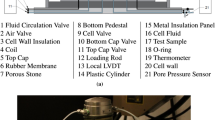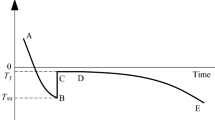Abstract
Containing a considerable amount of unfrozen water, frozen soil may produce excess pore-water pressure under external load, especially at temperatures near the thawing point. The variation of the pressure has a capability in influencing the deformation of frozen soils. In order to investigate the variation behavior of pore-water pressure in frozen soils and its relation to deformation, a series of pore-water pressure tests were conducted at subzero temperatures. A total of 13 frozen specimens were tested at various temperatures, and the pore-water pressures as well as the displacement were recorded. Then, variation behaviors of pore-water pressures and their effect on deformation were discussed. Results indicated that when a frozen soil sample is subjected to load, it responds with a slow increase in pore-water pressure in the early test stage up to a peak value, followed by subsequent extremely slow dissipation. The characteristic of pore-water pressure variations recorded in this study are closely correlated with temperature, soil type, and moisture content. Generally, the variation in pore-water pressure in frozen soils is caused by the coupled action of two opposing processes: an increasing process induced by solid matrix compression and a decreasing process induced by unfrozen water drainage. Thus, consolidation can be shown to occur as a component of compression and plays a significant role in the total deformation of warm frozen soils, although this effect decreases as decreasing soil temperature. However, it is difficult to distinguish the consolidation deformation from the creep deformation when taking into account the continuous variation in pore-water pressure throughout the test period.















Similar content being viewed by others
References
Akagawa S, Hiasa S, Kanie S, and Huang SL (2008) Pore water and effective pressure in the frozen fringe during soil freezing. In: Proceedings of the 9th international conference on permafrost, Fairbanks, Alaska, 29 June–3 July 2008. University of Alaska Fairbanks, Fairbanks, pp 13–18
Andersland OB, Ladanyi B (2004) Frozen ground engineering. Wiley, Hoboken
Arenson LU, Springman SM (2005) Mathematical descriptions for the behaviour of ice-rich frozen soils at temperatures close to 0 °C. Can Geotech J 42:431–442
Arenson LU, Springman SM (2005) Triaxial constant stress and constant strain rate tests on ice-rich permafrost samples. Can Geotech J 42:412–430
Arenson LU, Springman SM, Sego DC (2007) The rheology of frozen soils. Appl Rheol 17(1):12147-12114–12147-12141
Brodskaya AG (1965) Compressibility of frozen ground. DTIC document
Burt TP, Williams PJ (1976) Hydraulic conductivity in frozen soils. Earth Surf Process 1:349–360
Das BM (2008) Advanced soil mechanics. Taylor & Francis, New York
Eigenbrod KD, Knutsson S, Sheng DC (1996) Porewater pressures in freezing and thawing fine-grained soils. J Cold Reg Eng 10(2):77–92
Fukuda M (1983) The pore water pressure profile in porous rocks during freezing. In: Proceedings of the 4th international conference on permafrost, Fairbanks, Alaska, 17–22 July 1983. National Academy Press, Washington, D.C., pp 322–327
Harris C, Davies MCR (1998) Pressures recorded during laboratory freezing and thawing of a natural silt-rich soil. In: Proceedings of the 7th international permafrost conference, Yellowknife, Canada, 23–27 June 1998, pp 433–439
Hazirbaba K, Zhang Y, Hulsey JL (2011) Evaluation of temperature and freeze–thaw effects on excess pore pressure generation of fine-grained soils. Soil Dyn Earthq Eng 31:372–384
Hivon E, Sego D (1995) Strength of frozen saline soils. Can Geotech J 32(2):336–354
Kia M (2012) Measuring porewater pressures in partially frozen soils. Doctoral thesis, University of Alberta
Ma XJ, Zhang JM, Chang XX, Zheng B, Zhang MY (2007) Experimental study on creep of warm and ice-rich frozen soil. Chin J Geotech Eng 29(6):848–852 (in Chinese)
Miller RD (1973) Soil freezing in relation to pore water pressure and temperature. In: Proceedings of the 2nd international conference on permafrost, Yakutsk, Siberia, 13–28 July 1973. National Academy of Sciences, Washington, DC, pp 344–352
Nixon JF (1991) Discrete ice lens theory for frost heave in soils. Can Geotech J 28:843–859
Qi JL, Sheng Y, Zhang JM, Wen Z (2007) Settlement of embankments in permafrost regions in the Qinghai–Tibet plateau. Norsk Geogr Tidsskr Nor J Geogr 61(2):49–55
Qin YH, Zhang JM, Zheng B, Ma XJ (2009) Experimental study for the compressible behavior of warm and ice-rich frozen soil under the embankment of Qinghai–Tibet railroad. Cold Reg Sci Technol 57(2):148–153
Sayles F (1988) State of the art: mechanical properties of frozen soil. In: Fifth international symposium of ground freezing, Nottingham, pp 143–159
Seto J, Konrad JM (1994) Pore pressure measurements during freezing of an overconsolidated clayey silt. Cold Reg Sci Technol 22(4):319–338
Su K, Zhang JM, Liu SL, Zhang H, Ruan GF (2013) Compressibility of warm and ice-rich frozen soil. J Glaciol Geocryol 35(2):369–375 (in Chinese)
Vyalov S (1959) Rheological properties and bearing capacity of frozen soils. Academy of Science, Moscow (Translation, U.S. Army Cold Regions Research and Engineering Laboratory, SIPRE TL 74)
Vyalov SS (2005) Rheology of frozen soils. China Railway Press, Beijing
Wang J (2017) Laboratory study on mechanical properties of frozen clay through state concept. Doctoral thesis, Hokkaido University
Wang JC, Xu XZ, Zhang LX, Deng YS (1995) Experiment study of influence of soil type on ice formation and cryogenic structure of freezing soils. J Glaciol Geocryol 17(1):16–22 (in Chinese)
Wang SH, Qi JL, Yin ZY, Zhang JM, Ma W (2014) A simple rheological element based creep model for frozen soils. Cold Reg Sci Technol 106–107:47–54
Watanabe K, Osada Y (2016) Comparison of hydraulic conductivity in frozen saturated and unfrozen unsaturated soils. Vadose Zone J 15(5):7
Watanabe K, Wake T (2008) Hydraulic conductivity in frozen unsaturated soil. In: Proceedings of the 9th international conference on permafrost, Fairbanks, Alaska, 29 June–3 July 2008. University of Alaska Fairbanks, Fairbanks, pp 1927–1932
Williams PJ (1966) Pore pressures at a penetrating frost line and their prediction. Geotech 16(3):187–208
Williams PJ, Burt TP (1974) Measurement of hydraulic conductivity of frozen soils. Can Geotech J 11:647–650
Xu GF, Wu W, Qi JL (2016) Modeling the viscous behavior of frozen soil with hypoplasticity. Int J Numer Anal Methods Geomech 40(15):2061–2075
Xu GF, Wu W, Qi JL (2016) An extended hypoplastic constitutive model for frozen sand. Soils Found 56(4):704–711
Xu GF, Peng C, Wu W, Qi JL (2017) Combined constitutive model for creep and steady flow rate of frozen soil in an unconfined condition. Can Geotech J 54(7):907–914
Yao XL, Qi JL, Wu W (2012) Three dimensional analysis of large strain thaw consolidation in permafrost. Acta Geotech 7(3):193–202
Zhang LH, Ma W, Yang CS, Yuan C (2014) Investigation of the porewater pressures of coarse-grained sandy soil during open-system step-freezing and thawing tests. Eng Geol 181:233–248
Zhang H, Zhang JM, Zhang ZL, Chai MT (2016) Measurement of hydraulic conductivity of Qinghai–Tibet plateau silty clay under subfreezing temperatures. Chin J Geotech Eng 38(6):1030–1035 (in Chinese)
Zhang H, Zhang JM, Zhang ZL, Chai MT (2016) Investigation of the porewater pressure of saturated warm frozen soils under a constant load. J Offshore Mech Arct Eng 138(6):062001-1–062001-6
Acknowledgements
This project was supported by the National Natural Science Foundation of China (Nos. 41401087, 41471062, and 41471063), the State Key Laboratory of Frozen Soil Engineering (No. SKLFSE-ZT-35). We thank the editor and anonymous reviewers for their constructive comments.
Author information
Authors and Affiliations
Corresponding authors
Additional information
Publisher's Note
Springer Nature remains neutral with regard to jurisdictional claims in published maps and institutional affiliations.
Rights and permissions
About this article
Cite this article
Zhang, H., Zhang, J., Zhang, Z. et al. Variation behavior of pore-water pressure in warm frozen soil under load and its relation to deformation. Acta Geotech. 15, 603–614 (2020). https://doi.org/10.1007/s11440-018-0736-4
Received:
Accepted:
Published:
Issue Date:
DOI: https://doi.org/10.1007/s11440-018-0736-4




